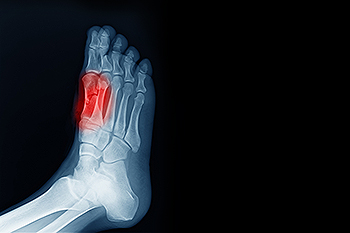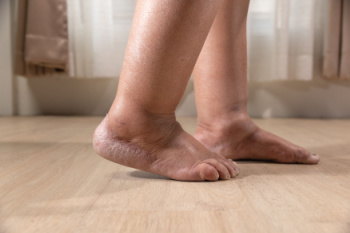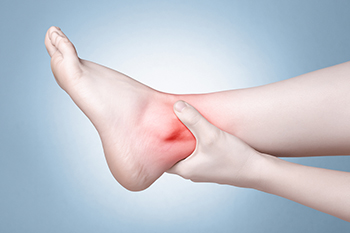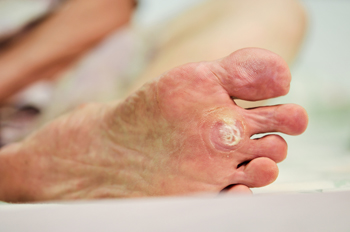Items filtered by date: July 2025
Big Toe Pain Caused by Sesamoiditis

Sesamoiditis is a painful condition involving two small bones located beneath the big toe joint. These sesamoid bones are embedded within a tendon that helps flex the big toe and absorb weight-bearing pressure. When repetitive stress or trauma affects this area, the surrounding tendon can become inflamed, causing pain beneath the ball of the foot. High-impact sports, foot injuries, poor foot mechanics, or shoes that lack adequate support can increase the risk of sesamoiditis. Symptoms include swelling, tenderness, and sharp pain when bearing weight or bending the big toe. This often builds gradually and may make walking or running difficult. A podiatrist can diagnose sesamoiditis by examining the foot, checking for tenderness, and ordering imaging tests to rule out fractures or other problems. In severe cases, surgery may be recommended to remove or repair the affected bone. If you have this type of pain in the big toe, it is suggested that you schedule an appointment with a podiatrist for an exam and appropriate treatment options.
Sesamoiditis is an unpleasant foot condition characterized by pain in the balls of the feet. If you think you’re struggling with sesamoiditis, contact one of our podiatrists of Lakewood Family Foot and Ankle. Our doctors will treat your condition thoroughly and effectively.
Sesamoiditis
Sesamoiditis is a condition of the foot that affects the ball of the foot. It is more common in younger people than it is in older people. It can also occur with people who have begun a new exercise program, since their bodies are adjusting to the new physical regimen. Pain may also be caused by the inflammation of tendons surrounding the bones. It is important to seek treatment in its early stages because if you ignore the pain, this condition can lead to more serious problems such as severe irritation and bone fractures.
Causes of Sesamoiditis
- Sudden increase in activity
- Increase in physically strenuous movement without a proper warm up or build up
- Foot structure: those who have smaller, bonier feet or those with a high arch may be more susceptible
Treatment for sesamoiditis is non-invasive and simple. Doctors may recommend a strict rest period where the patient forgoes most physical activity. This will help give the patient time to heal their feet through limited activity. For serious cases, it is best to speak with your doctor to determine a treatment option that will help your specific needs.
If you have any questions, please feel free to contact our office located in Lakewood, CA . We offer the newest diagnostic and treatment technologies for all your foot care needs.
Causes of Swollen Ankles and Feet

Swelling in the feet and ankles often occurs due to fluid accumulation in the soft tissues, known as edema. This can occur for many reasons, ranging from prolonged standing or walking to underlying health conditions such as heart, kidney, or liver disease. Injury, such as an ankle sprain or fracture, can also lead to localized swelling, as well as bruising or pain. Infections like cellulitis or abscesses may cause the skin to appear red, warm, or oozing. Swelling of the feet or ankles may affect one or both sides and can leave indentations when pressed, known as pitting edema. A podiatrist can evaluate the location, severity, and associated symptoms of swelling to help determine the underlying cause and recommend appropriate treatment. If you notice unexplained swelling of the feet and ankles, it is suggested that you make an appointment with a podiatrist for a diagnosis and treatment.
Swollen feet can be a sign of an underlying condition. If you have any concerns, contact one of our podiatrists of Lakewood Family Foot and Ankle. Our doctors can provide the care you need to keep you pain-free and on your feet.
Swollen feet are a common ailment among pregnant women and people who stand or sit for extended periods. Aging may increase the possibility of swollen feet and patients who are obese often notice when their feet are swelling too. There may be medical reasons why swollen feet occur:
- Phlebitis - A condition that causes the veins to become inflamed and can also cause leg pain.
- Liver disease - This may lead to low blood levels of albumin which is a protein. This can cause fluid in the blood to pass into the tissues and several areas of the body can become swollen.
- Heart failure - When the heart doesn’t pump properly the blood that is normally pumped back to the heart can pool in the veins of the legs causing swollen feet.
- Kidney disease - One of the main functions of the kidneys is releasing excess fluid in the body. This type of condition can make it difficult for the kidneys to function properly, and as a result the feet may become swollen.
- Deep-vein thrombosis (DVT)- This is a serious condition where blood clots form in the veins of the legs. They can block the return of blood from the legs to the heart which may cause the feet to swell. It is important to be treated by a podiatrist if this condition is present.
Swollen feet can also be caused by bone and tendon conditions, including fractures, arthritis, and tendinitis. Additionally, there may be skin and toenail conditions and an infection may cause the feet to swell. Patients who take medicine to treat high blood pressure may be prone to getting swollen feet.
Many patients elevate their feet to help relieve the swelling and this is generally a temporary remedy. When a podiatrist is consulted the reason behind the swelling can be uncovered and subsequently treated.
If you have any questions please contact our office located in Lakewood, CA . We offer the newest diagnostic and treatment technologies for all your foot and ankle needs.
Are You Suffering From Nerve Damage?
Uncomfortable Ankle Pain

The ankle plays a key role in movement and balance, making it prone to a wide range of injuries and conditions. Twisting or rolling the joint can result in a ligament strain, which is one of the most frequent reasons for ankle pain. Bone breaks may follow a fall, sudden impact, or sports accident. Over time, repeated motion or poor foot mechanics can lead to tendon irritation. Some people also develop joint inflammation that makes walking more difficult as stiffness and swelling increase. Pain may be steady or sharp, and movement can become limited depending on the cause. Ignoring these signs may lead to long-term weakness or instability. Early attention and proper support can make a difference in how well the joint recovers. If you have a swollen, painful ankle, or if it feels unstable, it is suggested that you see a podiatrist who can accurately diagnose ankle pain, and offer effective relief and treatment solutions.
Ankle pain can be caused by a number of problems and may be potentially serious. If you have ankle pain, consult with one of our podiatrists from Lakewood Family Foot and Ankle. Our doctors will assess your condition and provide you with quality foot and ankle treatment.
Ankle pain is any condition that causes pain in the ankle. Due to the fact that the ankle consists of tendons, muscles, bones, and ligaments, ankle pain can come from a number of different conditions.
Causes
The most common causes of ankle pain include:
- Types of arthritis (rheumatoid, osteoarthritis, and gout)
- Ankle sprains
- Broken ankles
- Achilles tendonitis
- Achilles tendon rupture
- Stress fractures
- Bursitis
- Tarsal tunnel syndrome
- Plantar fasciitis
Symptoms
Symptoms of ankle injury vary based upon the condition. Pain may include general pain and discomfort, swelling, aching, redness, bruising, burning or stabbing sensations, and/or loss of sensation.
Diagnosis
Due to the wide variety of potential causes of ankle pain, podiatrists will utilize a number of different methods to properly diagnose ankle pain. This can include asking for personal and family medical histories and of any recent injuries. Further diagnosis may include sensation tests, a physical examination, and potentially x-rays or other imaging tests.
Treatment
Just as the range of causes varies widely, so do treatments. Some more common treatments are rest, ice packs, keeping pressure off the foot, orthotics and braces, medication for inflammation and pain, and surgery.
If you have any questions please feel free to contact our office located in Lakewood, CA . We offer the newest diagnostic tools and technology to treat your foot and ankle needs.
How to Care for Plantar Warts

Plantar warts appear on the soles of the feet and are caused by a viral infection in the outer skin layer. They often develop in areas of pressure, such as the heel or ball of the foot, and may feel like stepping on a small stone. These warts can spread through skin contact or from walking barefoot on damp surfaces like gym floors or locker rooms. While some may go away on their own, others can grow, multiply, or cause discomfort with walking. Avoid picking at the area to prevent spreading the virus, and keep the foot clean and dry. For persistent or painful warts, or, if walking becomes difficult, seeing a podiatrist can help avoid further issues. If a plantar wart is not improving with home care, it is suggested that you consult a podiatrist for a proper evaluation and appropriate care.
Plantar warts can be very uncomfortable. If you need your feet checked, contact one of our podiatrists from Lakewood Family Foot and Ankle. Our doctors will assist you with all of your foot and ankle needs.
About Plantar Warts
Plantar warts are the result of HPV, or human papillomavirus, getting into open wounds on the feet. They are mostly found on the heels or balls of the feet.
While plantar warts are generally harmless, those experiencing excessive pain or those suffering from diabetes or a compromised immune system require immediate medical care. Plantar warts are easily diagnosed, usually through scraping off a bit of rough skin or by getting a biopsy.
Symptoms
- Lesions on the bottom of your feet, usually rough and grainy
- Hard or thick callused spots
- Wart seeds, which are small clotted blood vessels that look like little black spots
- Pain, discomfort, or tenderness of your feet when walking or standing
Treatment
- Freezing
- Electric tool removal
- Laser Treatment
- Topical Creams (prescription only)
- Over-the-counter medications
To help prevent developing plantar warts, avoid walking barefoot over abrasive surfaces that can cause cuts or wounds for HPV to get into. Avoiding direct contact with other warts, as well as not picking or rubbing existing warts, can help prevent the further spread of plantar warts. However, if you think you have developed plantar warts, speak to your podiatrist. He or she can diagnose the warts on your feet and recommend the appropriate treatment options.
If you have any questions, please feel free to contact our office located in Lakewood, CA . We offer the newest diagnostic and treatment technologies for all your foot care needs.
Preventing Falls at Work

Falls in the workplace often occur due to slippery surfaces, poor lighting, loose cords, or wearing improper footwear. These accidents can cause serious foot injuries such as fractures, sprains, and heel trauma that may lead to long recovery times. The feet are especially vulnerable during a fall because they often absorb the initial impact. A podiatrist can provide expert care for any resulting injuries and recommend footwear or orthotics to improve stability. Preventative advice may also include exercises to enhance balance. If you have sustained a foot or ankle injury during a fall, it is suggested that you schedule a consultation with a podiatrist who can offer effective treatment solutions.
Preventing falls among the elderly is very important. If you are older and have fallen or fear that you are prone to falling, consult with one of our podiatrists from Lakewood Family Foot and Ankle. Our doctors will assess your condition and provide you with quality advice and care.
Every 11 seconds, an elderly American is being treated in an emergency room for a fall related injury. Falls are the leading cause of head and hip injuries for those 65 and older. Due to decreases in strength, balance, senses, and lack of awareness, elderly persons are very susceptible to falling. Thankfully, there are a number of things older persons can do to prevent falls.
How to Prevent Falls
Some effective methods that older persons can do to prevent falls include:
- Enrolling in strength and balance exercise program to increase balance and strength
- Periodically having your sight and hearing checked
- Discuss any medications you have with a doctor to see if it increases the risk of falling
- Clearing the house of falling hazards and installing devices like grab bars and railings
- Utilizing a walker or cane
- Wearing shoes that provide good support and cushioning
- Talking to family members about falling and increasing awareness
Falling can be a traumatic and embarrassing experience for elderly persons; this can make them less willing to leave the house, and less willing to talk to someone about their fears of falling. Doing such things, however, will increase the likelihood of tripping or losing one’s balance. Knowing the causes of falling and how to prevent them is the best way to mitigate the risk of serious injury.
If you have any questions, please feel free to contact our office located in Lakewood, CA . We offer the newest diagnostic and treatment technologies for all your foot care needs.

